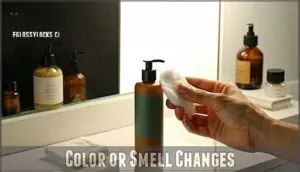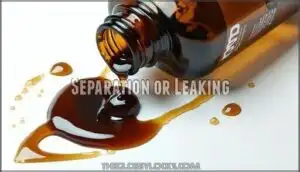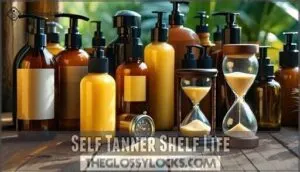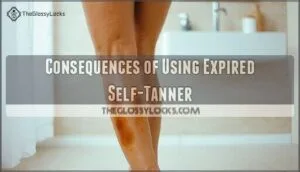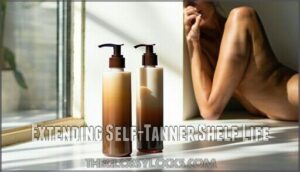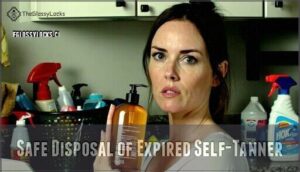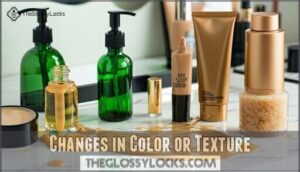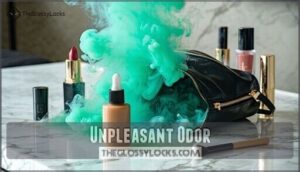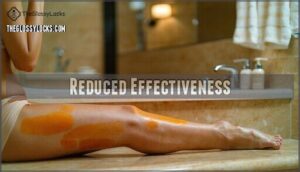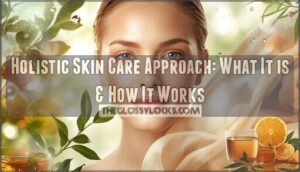This site is supported by our readers. We may earn a commission, at no cost to you, if you purchase through links.
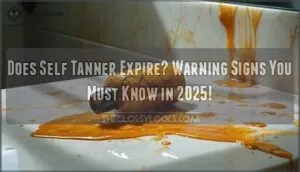
Most unopened self-tanners last 12-18 months, while opened products stay good for 6-12 months.
The active ingredient DHA breaks down over time, making your tanner less effective and potentially causing skin irritation.
You’ll know it’s gone bad when the color changes, it develops a funky smell, or the texture becomes clumpy or separated.
Think of it like food – when it’s off, you can tell, and using expired self-tanner won’t give you that golden glow you’re after, and it might leave you looking more patchy than perfect.
There are telltale warning signs that’ll help you spot when it’s time to toss that bottle.
Table Of Contents
- Key Takeaways
- Does Self Tanner Expire?
- Signs of Expired Self-Tanner
- Self Tanner Shelf Life
- Consequences of Using Expired Self-Tanner
- Extending Self-Tanner Shelf Life
- Safe Disposal of Expired Self-Tanner
- Signs of Spoiled Self-Tanner
- Frequently Asked Questions (FAQs)
- What happens if you use expired self tanner?
- Does self tanner go out of date?
- How long do self tanners last?
- Do self-tanners expire?
- Does self tan expire?
- How long does a self-tanner last in a jar?
- How do you know if self tan is expired?
- Can I use a 2 year old self-tanner?
- Is it okay to use old fake tan?
- How to know if fake tan is gone off?
- Conclusion
Key Takeaways
- Yes, your self-tanner does expire – Most opened bottles last 6-12 months, while unopened ones stay good for 12-18 months, so do not ignore those expiration dates on the packaging.
- You’ll know it’s gone bad by obvious warning signs – Watch for color changes, such as green tints, funky sour smells, a lumpy or separated texture, and a watery consistency that will not blend properly.
- Using expired self-tanner won’t harm you, but it ruins your results – You’ll get streaky, patchy, orange-tinted coverage instead of that smooth, golden glow you’re after, plus possible skin irritation.
- Store it properly to extend its life – Keep your self-tanner in cool, dry places away from heat and sunlight, seal containers tightly after use, and clean your application tools to maximize product effectiveness.
Does Self Tanner Expire?
Yes, self tanner expiration is real.
Your favorite tanning product has a shelf life just like food in your fridge. DHA degradation and ingredient breakdown happen over time, reducing product efficacy.
Just like that leftover pizza, your self-tanner won’t stay fresh forever—check those expiration dates!
Most self tanners last 12 months after opening, though packaging impact affects longevity. Batch codes help track manufacturing dates when expiration dates aren’t printed.
Expired self tanner won’t harm you, but self tanner shelf life matters for getting that perfect golden glow you’re after.
Signs of Expired Self-Tanner
You can spot expired self-tanner by checking for specific warning signs that indicate the product has gone bad.
Look for changes in color, texture, or smell, as these clear indicators mean it’s time to replace your tanning product.
Color or Smell Changes
Your self-tanner’s color changes and unpleasant smell serve as clear expiration signs.
Fresh products maintain consistent hues, but expired formulas develop a green tint or darkening color as DHA breaks down.
The self tanner smell transforms from neutral to a sour smell or harsh chemical odor.
You might notice the fading scent of pleasant fragrances replaced by rancid notes.
These changes occur because preservatives lose effectiveness over time.
Trust your nose—if something smells off, it’s time to toss that bottle before risking skin irritation.
Texture Variations
Over time, expired self-tanner develops noticeable texture changes that signal it’s past its prime.
Fresh products should feel smooth and blend easily, but expired self-tanner often becomes problematic.
Watch for these consistency changes:
- Lumpy Texture – Your once-smooth formula now feels bumpy with clumps that won’t dissolve, creating uneven coverage.
- Watery Consistency – The product separates and becomes thin, making application messy and results patchy.
- Grainy Feel – Thickening problems create a gritty sensation that won’t spread properly.
One might consider a consistent exfoliation routine to avoid such texture issues.
Separation or Leaking
When your self-tanner starts separating into layers or leaking from its container, it’s waving a red flag about product integrity.
These packaging defects signal compromised formulation stability that’ll ruin your tan. Poor storage impact and rough user handling accelerate these consistency changes in tanning products.
Watch for bad self tanner signs like oil separation or container damage—clear indicators your tanning product shelf life is up, and it may be due to improper storage.
Self Tanner Shelf Life
You’ll find that most self-tanners last about 12 months after you open them, while unopened products can remain effective for up to 2-3 years when stored properly.
The shelf life depends on factors like product type, packaging, and how well you store the product away from heat and light, which can affect the overall effectiveness.
Unopened Vs. Opened
Unopened self tanner enjoys a comfortable shelf life of 2-3 years when stored properly, while opened products face a ticking clock of 6-12 months.
Air exposure accelerates ingredient breakdown once you break that seal. Think of it like opening a bag of chips – freshness doesn’t last forever.
Check your expiration date and note when you first opened the bottle. Many people buy self tanner in advance for later use.
Storage Tips
Proper self tanner storage can make or break your product’s lifespan. You’ll want to find that sweet spot for optimal temperature – somewhere cool and dry, away from bathroom heat and humidity.
Think of your bedroom closet or a kitchen cabinet that doesn’t get warm from cooking. Sunlight exposure is your product’s enemy, so skip windowsills and bright countertops.
Air tightness matters too – always screw caps on tight after each use to prevent oxidation. The container type affects longevity, with pump bottles typically lasting longer than squeeze tubes.
Smart shelf placement means storing bottles upright to prevent leaks and separation. Consider self tanner organization for maintaining product quality.
These simple product storage tips can extend your self tanner shelf life substantially, keeping your glow game strong.
Shelf Life Duration
Understanding product longevity helps you maximize your self-tanner investment and achieve consistent results. Most self-tanners follow predictable expiration timelines that depend on whether you’ve cracked the seal.
Unopened self-tanners maintain ingredient stability for up to two years when stored properly. The original packaging protects active ingredients like DHA from air exposure and light damage.
Opened products have a shorter lifespan of 6-12 months due to formulation matters and storage impact. Once air enters the container, oxidation begins breaking down the tanning compounds. A key factor is DHA’s breakdown process, which reduces the product’s effectiveness over time.
Here’s how long different self tanner types typically last:
- Lotions and creams: 6-8 months after opening due to packaging effects and air exposure
- Mousses and foams: 8-12 months thanks to better sealed dispensers
- Drops and serums: 6-10 months depending on preservative quality
Remember, tanning product shelf life varies by brand and storage conditions. When self tanner goes bad, you’ll notice obvious signs before reaching these timeframes.
Consequences of Using Expired Self-Tanner
Using expired self-tanner can cause uneven tan results, skin irritation, and potential infections from bacterial growth.
You’ll likely experience streaky application, reduced color development, and possible allergic reactions that fresh products don’t typically cause, including uneven tan results.
Ineffective Tanning Results
When your expired self-tanner fails to deliver that coveted bronze glow, you’re left with disappointing results.
Self tanner effectiveness plummets once products pass their prime, creating uneven tan distribution across your skin. You might notice a streaky appearance instead of smooth coverage, or patchy tan areas that look blotchy. Some spots develop minimal bronzing while others remain untouched.
The dreaded orange tint often appears when DHA breaks down over time. Addressing uneven self-tan requires specialized products.
| Result Type | Visual Impact | Coverage Quality |
|---|---|---|
| Uneven Application | Blotchy patches | Poor distribution |
| Faded Color | Washed-out appearance | Inconsistent depth |
| Streaky Patchy Results | Zebra-like lines | Uneven blending |
Skin Irritation
Beyond poor tanning results, expired self-tanner can trigger uncomfortable skin irritation.
When DHA breaks down, it becomes more likely to cause allergic reactions, especially if you have sensitive skin. These irritation symptoms range from mild redness and itching to more severe reactions like rashes or bumps.
Your skin’s response depends on ingredient sensitivity and how long the product’s been expired.
Here’s what you should watch for:
- Redness or burning sensation within hours of application
- Itchy, bumpy patches that weren’t there before applying
- Unusual tingling or stinging during or after use
Always perform patch testing on a small skin area 24 hours before full application. This simple step helps identify potential skin reaction causes before they become widespread problems across your entire body.
Increased Risk of Infection
When bacterial contamination occurs in expired self-tanner, you’re opening the door to serious skin infections.
Your skin’s immune response kicks into overdrive, especially around open wounds or sensitive areas.
Poor product handling and hygiene practices create perfect breeding grounds for harmful bacteria.
This bacterial growth triggers severe skin reactions and skin sensitization.
Tanner color is brown for easy streak detection.
Prevention beats treatment every time.
Extending Self-Tanner Shelf Life
You can add months to your self-tanner’s lifespan by storing it properly and maintaining clean application habits.
Simple steps like keeping the container sealed tightly and storing it in a cool, dark place will prevent the active ingredients from breaking down too quickly, which is crucial for maintaining the product’s effectiveness and extending its lifespan.
Proper Storage Conditions
Your self-tanner’s survival depends on smart storage conditions. Proper temperature control and avoiding sunlight exposure can double your product’s lifespan.
- Store in cool dark places away from bathroom heat
- Prevent air exposure through tight container sealing
- Maintain consistent temperatures below 75°F
- Avoid product layering in direct sunlight areas
Optimal storage prevents premature product expiration.
Container Maintenance
Your container’s condition directly impacts your self-tanner’s product longevity. Proper cleaning protocols prevent material degradation and extend shelf life substantially. Regular maintenance protects against air exposure while preserving packaging quality.
Here’s how to keep your container in top shape:
- Wipe away residue buildup immediately after each use to prevent contamination
- Check airtight seals regularly to confirm they’re not cracked or damaged
- Clean pump mechanisms monthly with a damp cloth to prevent clogging
- Inspect for cracks that could compromise storage conditions and product integrity
These simple steps maximize your investment and keep your tanner working effectively.
Clean Application Tools
Your application technique directly impacts product longevity through proper applicator hygiene. Clean tanning mitts and brushes after each use with mild soap and water to prevent bacterial buildup.
Brush quality suffers when contaminated, while sponge cleanliness guarantees smooth application.
Always use dry hands when handling products. Mitt maintenance and regular cleaning extend tool lifespan, protecting your investment while maintaining superior application techniques.
Safe Disposal of Expired Self-Tanner
When you’ve determined your self-tanner has expired, you can’t just toss it in the regular trash without considering proper disposal methods.
Most expired self-tanners contain chemicals that require specific disposal procedures, so check your local waste management guidelines or contact the manufacturer for safe disposal instructions.
Compliance With Local Regulations
Local regulations govern proper disposal of expired self-tanner to minimize environmental impact.
Check your area’s disposal guidelines before tossing that old bottle.
Most waste management authorities recommend these steps:
- Mix with absorbent material like kitty litter or sawdust
- Seal in original container or leak-proof bag
- Place in household trash following local waste disposal guidelines
Your responsibility matters here.
Environmentally Conscious Disposal Options
Beyond following local waste disposal guidelines, you can make earth-friendly choices when tossing expired self-tanner.
Here are sustainable options that reduce environmental impact:
- Choose Biodegradable Packaging – Select brands offering compostable tubes and bottles that break down naturally instead of sitting in landfills forever.
- Support Sustainable Brands – Pick companies prioritizing eco-friendly disposal methods and minimal packaging waste.
- Explore Creative Reuse – Empty containers work perfectly for travel-sized products or DIY beauty recipes.
- Find Recycling Options – Many beauty retailers accept old tanner bottles through specialized recycling programs.
Consider environmental impacts for all waste.
Manufacturer Guidance for Disposal
Most brands provide specific disposal regulations on their packaging or websites. Check the manufacturer guidelines before tossing expired products.
Many companies now offer recycling programs to minimize environmental impact. When ingredients breakdown occurs, proper disposal prevents contamination.
Following brand instructions guarantees you’re handling your old tanner responsibly while protecting local water systems from harmful chemicals.
| Disposal Method | Manufacturer Recommendation |
|---|---|
| Original Container | Seal tightly, dispose in regular trash |
| Recycling Programs | Check brand websites for take-back options |
| Hazardous Waste Centers | For products with chemical warnings |
| Local Regulations | Follow municipal disposal guidelines |
| Environmental Impact | Never pour down drains or toilets |
Signs of Spoiled Self-Tanner
You’ll know your self-tanner has spoiled when you notice clear changes in its appearance, smell, or texture.
These warning signs include color shifts, separation of ingredients, unusual odors, and thickened or watery consistency that affects how the product applies to your skin, which can be indicated by unusual odors.
Changes in Color or Texture
Your self-tanner’s appearance tells the whole story regarding spoilage. Color degradation and texture separation are dead giveaways that your product has gone bad.
When expired selftanner develops these issues, it’s time to toss it.
Here are five key visual signs your self-tanner has expired:
- Green tint appears instead of the original golden-brown shade
- Lumpy consistency replaces the smooth, creamy texture
- Watery formula separates into distinct layers
- Consistency change from flowing liquid to thick, clumpy paste
- Color change from light tan to dark, muddy brown
Unpleasant Odor
When you notice odor changes in your self-tanner, it’s time to ask "is my tanner expired?" A simple sniff test reveals whether your product has gone bad.
Here are key warning signs:
- Sour or Rancid Smell: Fresh self-tanners have a neutral or slightly sweet product scent, but expired ones develop sharp, unpleasant odors due to ingredient breakdown.
- Increased Odor Intensity: Even mild scent changes signal cosmetic expiration.
- Chemical-Like Smell: Harsh, chemical odors indicate your self tanner has definitely gone bad and needs immediate disposal for safety.
Don’t try masking odor with perfumes – it won’t fix the underlying issue.
Reduced Effectiveness
Your self-tanner’s reduced effectiveness becomes obvious when you can’t achieve that golden glow anymore.
You’ll notice uneven application, fading color, and patchy results that scream "time for a replacement." When cosmetic expiration hits, slower development and inconsistent tan coverage follow.
| Effectiveness Issue | What You’ll See | Why It Happens |
|---|---|---|
| Uneven application | Streaky, blotchy patches | DHA breakdown affects formula consistency |
| Fading color | Lighter than expected results | Active ingredients lose potency over time |
| Slower development | Takes longer to show color | Chemical compounds degrade with age |
| Patchy results | Inconsistent tan coverage | Product separation creates uneven distribution |
Frequently Asked Questions (FAQs)
What happens if you use expired self tanner?
Using expired self-tanner won’t harm you, but you’ll likely get streaky, uneven results. The color may appear patchy or orange, and you might experience mild skin irritation or breakouts.
Does self tanner go out of date?
Yes, self-tanner does go out of date.
You’ll typically get 12 months after opening and up to 2-3 years unopened.
Watch for texture changes, odd smells, or color shifts signaling it’s time to toss it.
How long do self tanners last?
Most self-tanners last 12 months after you open them, though unopened bottles can stay good for up to 2-3 years. Your product’s lifespan depends on storage conditions and packaging type.
Do self-tanners expire?
Absolutely, your self-tanner does expire. Most products last about 12 months after opening, though unopened bottles can stay good for up to 2-3 years when stored properly in cool, dark places.
Does self tan expire?
Most self-tanners collect dust for months past their prime.
Your self-tan does expire, typically lasting 12 months after opening or up to 2-3 years unopened when stored properly in cool, dark places.
How long does a self-tanner last in a jar?
A jar of self-tanner typically lasts 12 months after you’ve first opened it. The wide opening exposes more product to air, which breaks down the active ingredients faster than pump bottles.
How do you know if self tan is expired?
Check for color changes like green tints, lumpy or separated texture, and unusual odors. Your self-tanner’s gone bad when it smells off, feels chunky, or applies unevenly—trust your senses.
Can I use a 2 year old self-tanner?
Using a 2-year-old self-tanner isn’t recommended.
If unopened and stored properly, it might still work, but you’ll likely get streaky, uneven results.
Do a patch test first to check for irritation or effectiveness.
Is it okay to use old fake tan?
Like milk past its prime, old fake tan won’t poison you but might leave streaky, patchy results.
You can try it, but expect weaker color and possible skin irritation.
Fresh product works better.
How to know if fake tan is gone off?
Your fake tan’s gone bad if it smells funky, looks chunky or watery, changes color to green or darker shades, or separates into layers.
Trust your nose and eyes—they’ll tell you when it’s time to toss it.
Conclusion
Sarah discovered her year-old self-tanner had turned orange and smelled sour, resulting in streaky patches instead of her desired bronze glow.
Remember, does self tanner expire isn’t just a question—it’s essential for your skin’s health and appearance.
Check expiration dates, watch for color changes, funky odors, and texture separation.
Store products properly in cool, dry places to maximize shelf life.
When in doubt, toss it out.
Your skin deserves fresh, effective products that deliver beautiful, even results every time.

